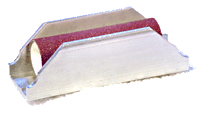| |||
F R O M F L A T T O C O N C A V E :
| |||
| |||
Which for What ROH?Generally speaking, if you don’t know what ROH you have, try the test described below. In fact, for best results and to learn how best to use SkateMate, try this procedure in the beginning anyway! MARKER PEN TEST:
And, of course, there are hundreds of ROH dimensions used between these figures depending on the individual skater’s own ideas [ or — more often — the trainer’s or the coach’s ideas ]. Luckily, SkateMate will sharpen them all with a little ‘practice“. Remember: SkateMate is not meant to replace your professional grinding job, it is meant to extend the time interval between grindings. Retaining Your Individual ROHFurthermore, it is clear that the SkateMate cylinder may sometimes not ‘reach’ all the way down into the hollow of deeply ground blades [ ROH < 9.52 mm or 3/8 in. ], but it will always hone the edges sharp enough to skate on just the same. The difference is very minute, but after sharpening such blades with SkateMate for extended periods, it is recommended that they be reground on a correctly shaped wheel—that is, if such a precise and accurate hollow shape is of importance to your skating. And, assuming you can find such a wheel, and someone who knows how to use it. So, if you have an ROH that is 3/8" or smaller, why not order the RETROFIT KIT—then you can skate for years and years without ever having to set foot in a costly sharpening shop. NOTE: The grinding wheels in shops remove a lot more steel from your blades than SkateMate ever will, so, with SkateMate, your blades last a lot longer. Grinding wheels are exactly what they are, they ‘grind’ away the steel—and quite a bit each time. The only real reason to ‘grind’ blades is if you have been walking to the rink with your skates on, and no ROH and no edges are left. SkateMate does not wastefully ‘grind’ off your blades, it merely removes small nicks and ‘hones’ your existing edges to ultimate sharpness (and often better than any wheel). Modern Tapered Blades [ Warning! ]Some modern skate blades have been given a taper from front to back and/or from top to bottom ( non-parallel sides, i.e. the blade width varies. Also called side-honed, see below. ). The reasons for this are legion—mostly subjective as far as I am concerned. These blades are extremely difficult to grind correctly even on conventional bench machines ( even tricky on computerized ones ) and are also difficult to resharpen using SkateMate. If you have purchased such blades, be extremely careful about where and by whom you get them sharpened. FACT: The vast majority of grinding shops these days cannot even center a regular skate blade correctly. This leads to one edge being higher than the other. Yet another reason for buying SkateMate! Because it can even fix that, if you use a 100-grade cylinder. ( SKATER’S EDGE SOURCEBOOK, p. 46. ):
* Side-honed: The lower portion of the blade . . . is tapered from top to bottom, theoretically making sharper edges possible. Because the sides of the blade are no longer parallel, precise sharpening can be difficult. Stainless Steel and Super SteelThe question often arises about whether SkateMate can sharpen stainless steel or super-steel blades, or super-hard speed skate blades. In the first place, any metallurgist will tell you that stainless steel is not as hard as ‘standard’ hardened steel, nor does it keep an edge as well. Sharpening stainless steel is absolutely no problem for SkateMate even in the case of brittle speed-skate blades. GOOD LUCK, AND GOOD SKATING! for homepage & true testimonials
|





